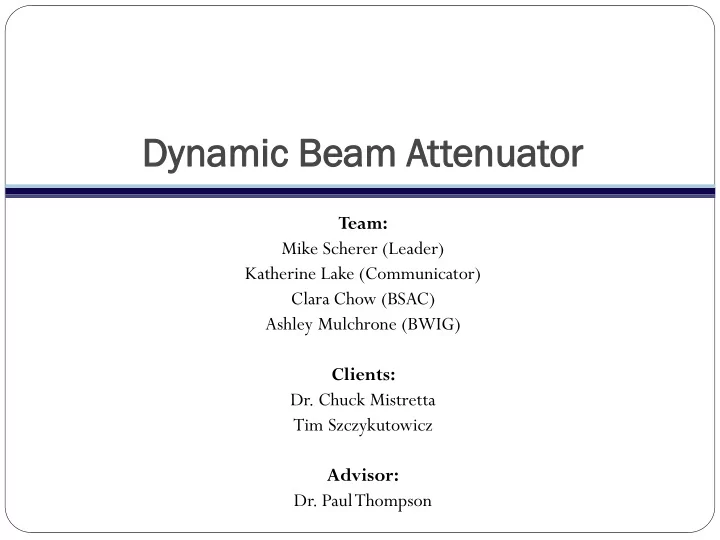

Dy Dyna namic mic Beam Attenua enuator or Team: Mike Scherer (Leader) Katherine Lake (Communicator) Clara Chow (BSAC) Ashley Mulchrone (BWIG) Clients: Dr. Chuck Mistretta Tim Szczykutowicz Advisor: Dr. Paul Thompson
Background Clients: Dr. Mistretta and Tim Szczykutowicz X-Ray Computed Tomography 1,2 (CT) X-Rays to image multiple planes in body Uses: Diagnostic Imaging 3,4 CT-Guided Procedures 5 C-arm CT 6
Problem Definition Current CT scans lack dynamic dose modulation 7,8 High x-ray doses Low quality images Competing devices: Bowtie filters kVp modulation No dynamic filters Attenuation heterogeneity across the body
Design Criteria X-ray source Client Proposal: Attenuate X-Ray dosages 7 Wedge thickness Changes over time More attenuation, Improve signal to noise less x-rays pass uniformity Budget: ~$5000 Goal: Proof of concept Design new wedges with Less attenuation, actuation more x-rays pass
Current Prototype 10 steel wedges Fixed wedge plate on the top Very heavy Cannot optimally attenuate One wedge attached to one motor Current prototype with 10 steel wedges 7
Material thickness & Beam Hardening Matlab simulations to model the wedge thickness required to attenuate 36 cm of soft tissue and 1 cm of bone Beam hardening: Energy change of x-rays as it passes through the material Linear attenuation coefficients Thickness required for every element
Wedge Material Heel Thickness (mm) Aluminum 129.7 Iron 16.3 Copper 11.4 Lead 2.5 Tungsten 1.2
Materials Design Matrix Criteria Weight Lead Tungsten Copper Iron Aluminum Leaf Thickness 4 4.91 10 1.06 0.74 0.09 Beam Hardening 2.5 7.96 10 7.36 7.4 8.23 Machinability 2 6 2 6 8 10 Cost 1 2.33 0.10 1.36 4.27 10 Weight/Heaviness 0.5 8.33 10 2.27 1.80 0.66 Total 58.0 74.1 37.1 42.6 51.3 (out of 100) Note: Values quantitatively determined and normalized to a scale from 1 to 10. Each criteria was weighted so that the grand total was from 1 to 100.
Wedge Actuation Wedge with linear actuator Wedge with rack and pinion
Preliminary Design Tungsten wedges with rack and pinion actuation in flush configuration Motors placed on same side with alternating positions Actuation and configuration may not be the final design Proposed design based on size restraints (Wedge thickness not drawn to scale)
Future Work Machine wedges and housing Select, purchase, and implement actuation mechanism Assemble entire device Program the device Test with phantoms
Acknowledgements Clients: Chuck Mistretta and Tim Szczykutowicz Advisor: Dr. Paul Thompson Siemens engineer: Kevin Royalty Erick Oberstar References [1] Herman, G.T., Fundamentals of computerized tomography: Image reconstruction from projection, 2 nd edition, Springer, 2009 [2] Goldman, L., Principles of CT and CT Technology . J. Nucl. Med. Technol, vol. 35, no. 3, pp. 115-128, 2007. [3] Takahashi, M. et al., Mycobacterium kansasii pulmonary infection: CT findings in 20 cases . Jpn J Radiol, 2012. [4] Greco, A. et al., Reproducibility and accuracy of non-invasive measurement of infarct size in mice with high-resolution PET/CT. J Nucl Cardiol, 2012. [5] Nakatani, M. et al., Analysis of factors influencing accuracy and complications in CT-guided lung biopsy. Minim Invasive Ther Allied Technol, 2012. [6] http://www.healthcare.philips.com/pwc_hc/main/shared/Assets/Imates/CT/Visualization_software/oa_ct_viewer_16_en_lrg.jpg [7] Szczykutowicz, T., Intensity Modulated Computed Tomography . Dissertation in progress. [8] C. H. McCollough, M. R. Bruesewitz and J. J. Kofler, CT Dose Reduction and Dose Management Tools: Overview of Available Options. RadioGraphics, vol. 32, no. 1, pp. 503-512, 2006.
Recommend
More recommend